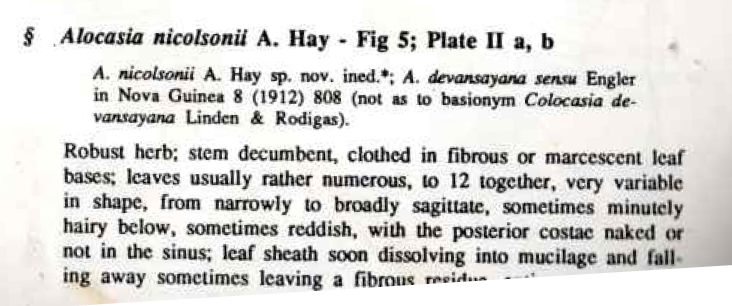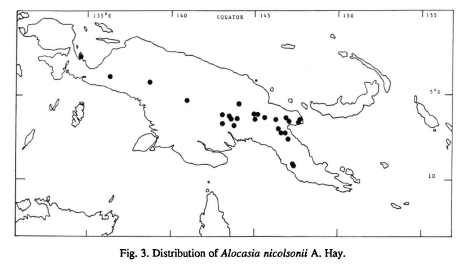ALOCASIA NICOLSONII
ORIGINAL DESCRIPTION:
First described in Alistair Hay’s Aroids of Papua New Guinea (1990) and then further expanded upon in Blumea 35 (1991)
Aroids Papua New Guinea: 31 (1990)
[Alocasia devansayana auct. non (Linden & Rodigas) Engler: Engler in Lorentz, Nova Guinea 8 (1912) 808; Krause in Engler, Pflanzenr. 71 (1V.23E) (1920) 88, fig. 16; excl. basionym i.e. Colocasia devansayana Linden & Rodigas, 111. Hort. (1886) 97, t. 601, = Alocasia spec, dub., vide infra.]
Ab aliis speciebus Alocasiae cognitis vagina deliquescente, spatha fructifera rubescente, synandriis impressis, appendice tenue differt
Typus: Papua New Guinea, Eastern Highlands Prov., Kainantu District, nr Aiyura, 1st February 1989, Hay & Wise 4047 (LAE, holo; NSW, iso).
SYNONYMS: N/A
DISTRIBUTION: New Guinea
CLIMATE: Tropical humid climate
Humidity is moderate throughout the year, ranging from 60% to 70%
Temperature is varies between the seasons - within the range of 48°F/9°C to 88°F/31°C during the day. Minimum temperatures never dip below 45°F/7°C
Rainy and humid season (October to May) and a dry season between June and October. The average annual rainfall is 1,200 mm
ECOLOGY: Widespread in mid-montane* rainforest in damp places from c. 1700-2700 m altitude
SPECIES DESCRIPTION:
Robust herb; rhizome decumbent, to c. 8 cm diam., clothed in fibres or old leaf bases; leaves numerous, to 12 together; petiole to c. 90 cm long, often with few to numerous scattered glands on the abaxial surface, sheathing in the lower half to 3/5, the wings of the sheath deliquescent and mucilaginous at the emergence of the enclosed leaf; blade narrowly sagittate to ovato-sagittate, dull or slightly glossy green adaxially, paler abaxially, sometimes there with reddish-purple pigment except near the margins and midrib; anterior lobe to 37 cm long, c. 15-34 cm wide, the tip usually somewhat acute and apiculate, with to 12 primary veins on either side of the anterior costa diverging at an angle of c. 70 degrees, these sometimes forked, often sporadically emitting veins intermediate in thickness between the primary and secondary venation (i.e. subsidiary veins); primary venation impressed adaxially at least distally, prominent abaxially; secondary venation impressed adaxially, prominent abaxially; tertiary venation fine to forming a bold prominent reticulum abaxially; costae, primary, secondary, and tertiary venation sometimes densely covered with minute, multicellular, distally branched hairs abaxially, or glabrous; costae and primary veins often bearing glands in the axils of the primary and larger subsidiary veins respectively; posterior costae 7-20 cm long, diverging at 70-100 degrees, naked in the sinus for c. 1-5 cm or with laminar tissue (sometimes only a very narrow wing) extending into the sinus to the petiole, but not peltate; posterior lobes with the tips acute, narrowly blunt-tipped, overlapping each other when posterior costae diverging at an acute angle; inflorescences paired, each pair subtended by a rapidly deliquescent cataphyll, its remains often stuck to the spathe; peduncle barely carrying the base of the spathe clear of the subtending leafbases; spathe white, sometimes faintly flushed pink on the margin near the base, c. 15 cm long, constricted c. 1/3 of the way from the base, the lower portion more or less irregularly triangular in cross section, the limb rather narrow, c. 2.4 cm wide, opening wide, eventually deflected, then deliquescing after anthesis; fruiting spathe much expanded, c. 3.5 cm diam., 7 cm long, brilliant red, later dehiscing longitudinally; spadix c. 13 cm long; female zone 7-11 mm long at anthesis, c. 9 mm diam. with c. 20-70 pistils; ovary green, 1.5-c. 3 mm diam., unilocular, sometimes apically incompletely 3- or 4-septate; stigma button-like to very indistinctly 3- or 4-fid, white, papillate, on a very short style; ovules hemianatropous to anatropous; interstice of sterile organs c. 3-4 cm long, rather massive in the lower half, c. 1.2 cm diam., there composed of several large, hexagonal to rhomboid, sometimes somewhat swollen, sometimes impressed structures, thence sharply tapering to c. 3.5 mm diam.; male zone c. 4-5 cm long, c. 7 mm diam.; synandria more or less regularly hexagonal, 3-4 mm diam., distinctly impressed in the centre of the top, white, the anthers opening by apical pores; appendix slender, c. 3.5 mm diam., c. 5 cm long, white, irregularly sulcate, synandrodial at base, turning deep brown in spirit, rarely very much reduced; berries deep orange, to 1.2 cm across; seeds several, globose to compressed, c. 5 mm across, dark brown, prominently strophiolate at the chalaza.
INFLORESCENCE:
Inflorescences c. 4 together, smelling sweetly of citrus apparently from the lower part of the spadix; subtending cataphylls at first colored like the petiole, then marcescent, exceeding the peduncle and lower spathe; peduncle short, completely concealed by leaf and cataphyll bases. Spathe c. 6 cm long; lower part of spathe ovoid, 2.5 cm long, ivory, dotted deep purple; spathe limb oblong-lanceolate, abaxially colored like the lower spathe, unmarked within, the margin purple, at first erect-cucullate, then reflexed. Spadix somewhat shorter than the spathe, c. 5 cm long, sessile; female zone 1 cm long, c. 8 mm wide; ovaries ovoid, pale green; style c. 1 mm long, not abruptly differentiated from ovary, slightly ascending; stigmas ivory-white with 2-3 drop-shaped lobes; sterile interstice 4 mm long, somewhat attenuate and lax basally, c. 4 irregular whorls of synandrodia, the lower ones reduced, the upper ones resembling sterile synandria; male zone ivory, 1.2 cm long, c. 5 mm diam., c. half within the lower spathe chamber, the rest exserted; synandria rhombo-hexagonal, c. 2 mm diam., the thecae not overtopped by synconnective; appendix buff, c. 2 cm long, c. 5mm diam., distally tapering, somewhat constricted at junction with male zone. Fruit unknown.
VARIEGATED FORMS: N/A
ETYMOLOGY: The species is named for D.H. Nicolson, Smithsonian Institution, in acknowledgement of his contribution to knowledge of the Araceae of the Eastern Tropics. Dr. Nicolson was the first to recognize this species as new.
NOTES: Alocasia nicolsonii is extraordinarily variable, and constitutes an 'ochlospecies'. If only a few populations are examined, it is difficult to accept that only one species is involved. Unifying characters include the deliquescent leaf sheath, the attenuate interstice, the impressed synandria, the narrow appendix, the red short-pedunculate fruiting spathe, and the altitudinal range and habitat. Varying characters include leaf shape - from broadly ovato-sagittate to narrowly sagittate; posterior costae - naked in the sinus to lamina-bearing to the petiole; texture of the leaf surface - from glossy to dull; density of gland distribution on the leaf blade underside and petiole - from abundant to absent; tertiary venation - from boldly reticulate to fine and inconspicuous; indumentum on the leaf blade underside - from dense to absent; color of the leafb lade underside - from green to red; size and number of pistils - from small and numerous to bigger and fewer; and form of the organs of the sterile interstice - from inflated to impressed. Figures 1 & 2 illustrate representatives from two populations, the first near Wau, Morobe Prov., the second near Aiyura, Eastern Highlands. The variation, represented in table 1, is not without pattern, though it is too complex for nomenclatural recognition. Identical combinations of characters recur through the range, while very different combinations of characters are found in plants from proximate localities.
The two widely differing populations that Hay studied, at first hand each appeared homogeneous. The term 'ochlospecies' - literally an unruly mob species - was coined by White (1962) for cases where a species may be said to be neither monotypic nor polytypic. It is used here to convey the state of affairs in Alocasia nicolsonii where there seems to be extensive infra-specific parallelism, where there is possibly the evolution of local isolating mechanisms, and yet where morphological distinctions break down when variation over the whole range is considered.
Engler (I.e.) attributed material of this species to Alocasia devansayana (Linden & Rodigas) Engler, based on Colocasia devansayana Linden & Rodigas. Colocasia devansayana is evidently an Alocasia, but it is based on sterile material of horticultural origin which cannot be determined with certainty. It was illustrated, however (in Linden & Rodigas, I.e.), showing the leaf sheath to be persistent, and the binomial therefore cannot possibly be rightly applied to the species described here.
Okada & Carson (1980) described 11 new species of fruit flies of the genus Drosophila (Diptera: Drosophilidae) from the inflorescence of this species, citing it as ‘Alocasia macrorrhizos’.
Other specimens seen (in alphabetical order of collector, by country):
IRIAN JAYA. 9 km NE of Lake Habbema, Brass 10973 (A, BO); 18 km NE of Lake Habbema, Brass 11287 (A); Wissel Lakes area, Eyma 4575 (BO); Mt Wondiwoi, Mayr 391 (BO); Okwalimkan R., headwaters, NGF 33127 (LAE); Mt Hellwig, Pulle 678 (BO, K), von Romer 1075, 1128 (BO).
PAPUA NEW GUINEA. Western Highlands Prov., Yaibos, nr Wabag, ANU 2270 (CANB), 2333 (A, CANB, LAE); Eastern Highlands Prov., above Aiyura Ag. Station, ANU 5576 (CANB, LAE); Southern Highlands Prov., Onim, Mt Giluwc, ANU 20410 (LAE); Western Highlands Prov., Kurupili, Kepalu, Upper Kaugel, Bowers 197, 632 (CANB, LAE); Central Prov., Boridi, Carr 13103 (CANB, L); Isuariva, Carr 16073 (L); Morobe Prov., Wau, Mt Kaindi, Bulldog road, Carson 4 (LAE); Sattelbcrg, Sambanga, Clemens 7758 (A, L); Sattelberg, Clemens & Clemens 684 (A, L), 1894 (A); Ogerammang, Clemens & Clemens 5029 (A); Southern Highlands Prov., Mendi, Frankel 7 (LAE); Eastern Highlands Prov., W of Fatima R., Marafunga Mill, Goroka,, Grubb & Edwards 134 (L); Morobe Prov., Wau-Biaru road, c. 30 km from Wau, Hay & Roberts 4023 (NSW); Eastern Highlands Prov., Sinasina, 2 mi SSW of Koge Mission, Hide 481 (LAE); Morobe Prov., Kasanombe, 40 km N of Lae, Jacobs 8681 (L, LAE); Western Prov., Mt Bosavi, N side, Jacobs 9409 (L, LAE); Eastern Highlands Prov., Goroka, Marafunga, LAE 53277 (LAE); Morobe Prov., 7 km W of Aseki, LAE 54805 (CANB, L, LAE, US); Eastern Highlands Prov., Goroka, Gahavisuka Provincial Park, LAE 56689 (LAE); Central Prov., nr Boridi Village, LAE 60269 (LAE, US); Southern Highlands Prov., Onim Hill, S slopes of Mt Giluwe, LAE 60880 (A, BRI, K, L, LAE); E Iaro R., S slope of Mt Giluwe, LAE 60939 (BRI, L, LAE, US); Eastern Highlands Prov., Aiyura, NGF 6948 (BRI, LAE); Western Highlands Prov., Nondugl, NGF 13842 (A, LAE); Eastern Highlands Prov., Kumul Mission, Chuave-Chimbu road, NGF 14135 (A, BRI, L, LAE); Western Highlands Prov., Wabag, Sirunke, NGF 14285 (L, LAE); Morobe Prov., Zatari, SE of Bona, NGF 17512 (L, LAE); N of Wagau airstrip, NGF 17876 (BRI, L, LAE); Morobe Prov., Tawa Village, nr Aseki, NGF 27630 (CANB, L, LAE); Southern Highlands Prov., Habono Rest House, 6.5 mi NW of Mt Ne, NGF 32078 (LAE); Central Prov., E side of Lake Myola No. 2, NGF 34592 (LAE, US); Efog'.
NGF 34870 (LAE, US); Morobe Prov., Wau, Head of Bulolo R., NGF 35641 (LAE); Eastern Highlands Prov., Lufa, NGF 35735 (BRI, LAE, US); Western Highlands Prov., Dagarunga Ridge, Baiyer-Jimi Divide, NGF 38887 (L, LAE, US), NGF 38888 (L, LAE, US); Baiyer road, 4 mi from Mt Hagen, Nicolson 1393 (A, BO, LAE); Kuta, nr Wankl, Robbins 32 (CANB); Mt Hagcn, Togaba sawmill, Nebelyer Divide, Robbinss 480 (CANB); Southern Highlands Prov., Halalinja, Nipa Dist., Silliloe 82115 & 82116 (UPNG); Eara Range, 11 km NW of Erave, Streimann 8553 (LAE); Telabo, Tari, UPNG 1779 (UPNG); Western Highlands Prov., Kubor Range, Vinba, Nona-Minj Divide, Vink 16513 (CANB, L, LAE); Southern Highlands Prov., Tari, Tigibi, Vink 16845 (A, CANB, L, LAE); Lei R., SE foot of Mt Ambua, Vink 17479 (A, CANB, L, LAE); Eastern Highlands Prov., Aiyura, road to Arona, Winters & Higgins 206 (CANB).
CULTIVARS: N/A
HYBRIDS: N/A













